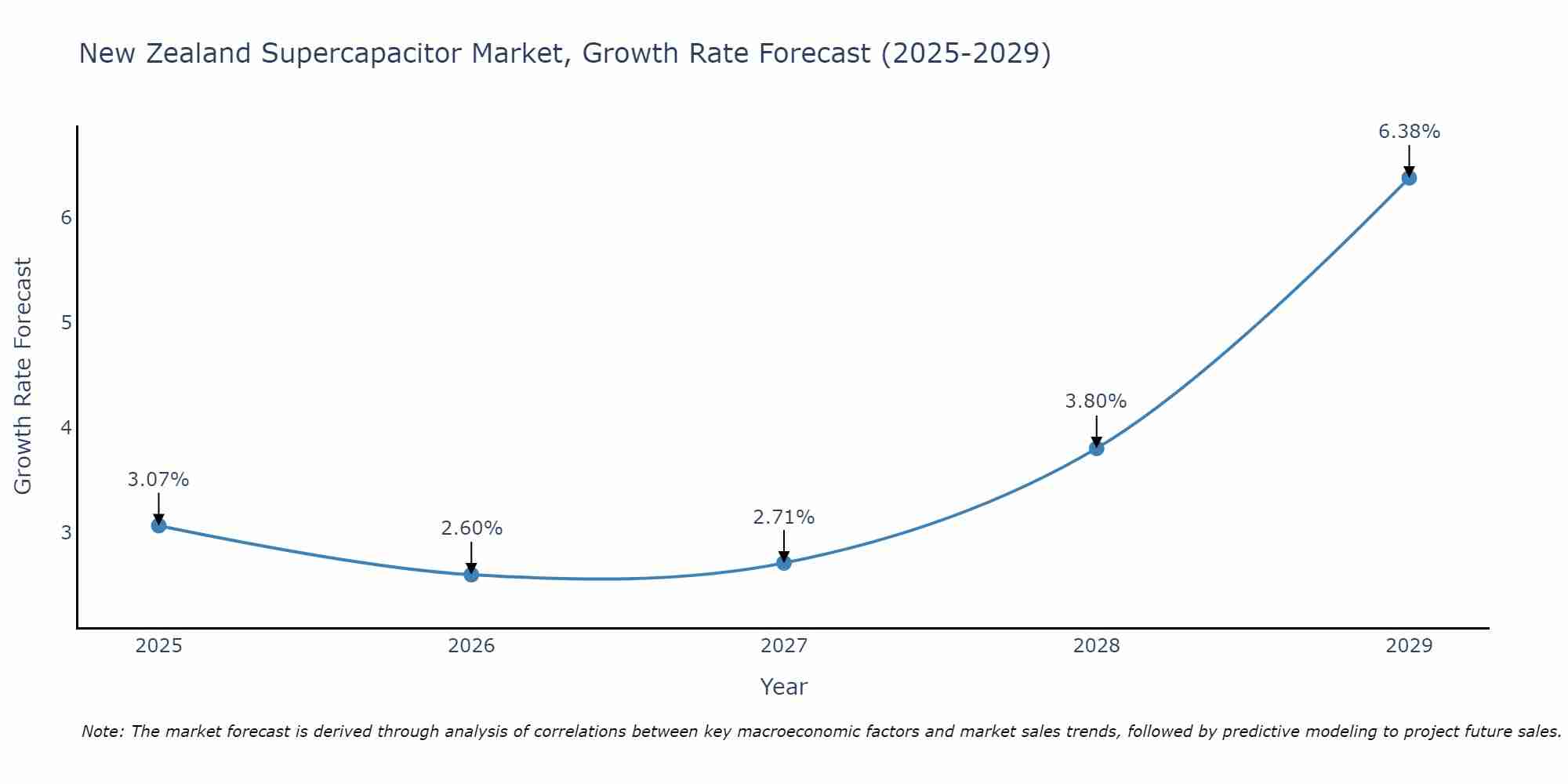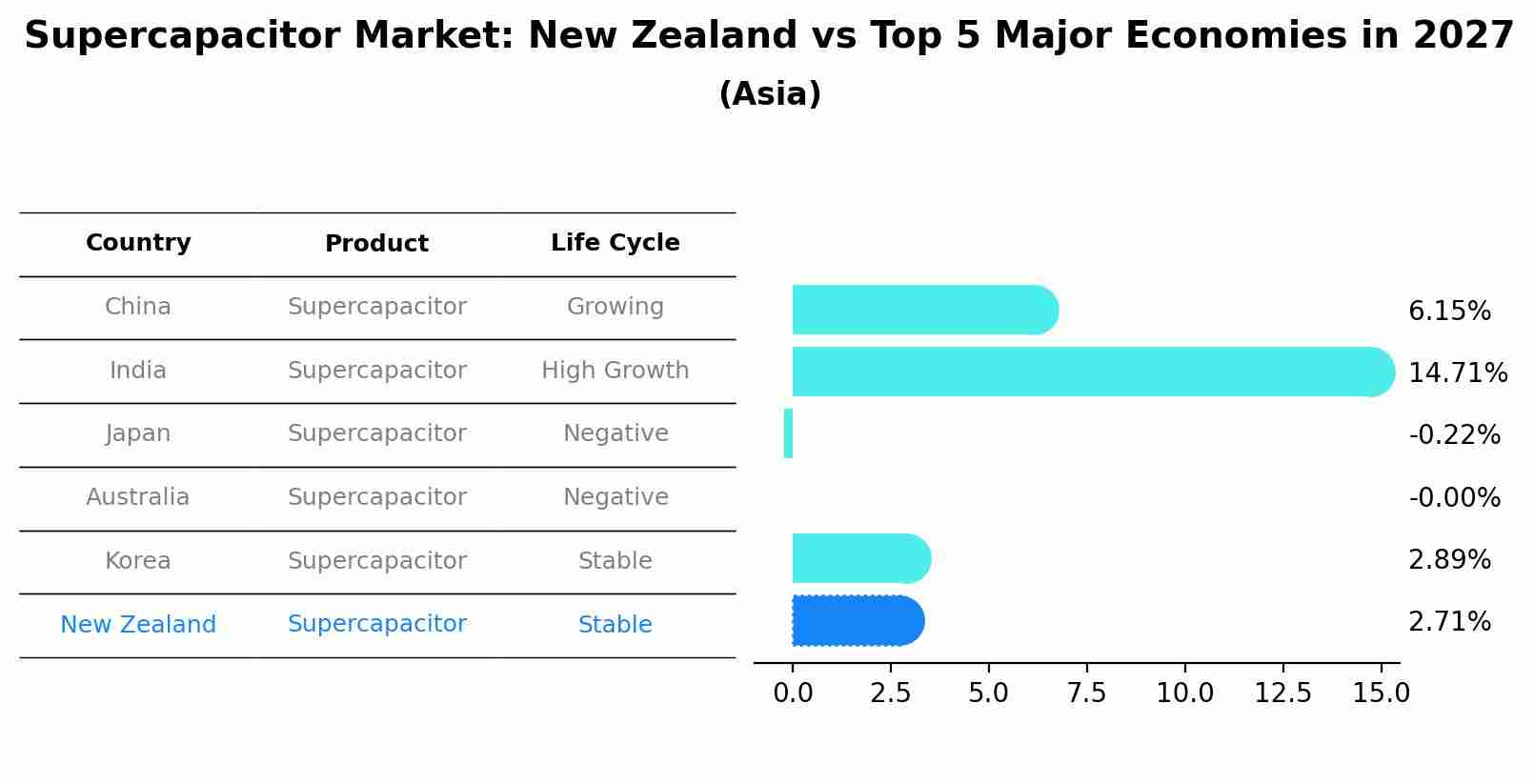New Zealand Supercapacitor Market (2025-2031) | Companies, Growth, Revenue, Trends, Size, Outlook, Analysis, Segmentation, Share, Value, Forecast & Industry
| Product Code: ETC5139198 | Publication Date: Nov 2023 | Updated Date: Sep 2025 | Product Type: Market Research Report | |
| Publisher: 6Wresearch | Author: Bhawna Singh | No. of Pages: 60 | No. of Figures: 30 | No. of Tables: 5 |
New Zealand Supercapacitor Market Size Growth Rate
The New Zealand Supercapacitor Market is projected to witness mixed growth rate patterns during 2025 to 2029. From 3.07% in 2025, the growth rate steadily ascends to 6.38% in 2029.

Supercapacitor Market: New Zealand vs Top 5 Major Economies in 2027 (Asia)
In the Asia region, the Supercapacitor market in New Zealand is projected to expand at a stable growth rate of 2.71% by 2027. The largest economy is China, followed by India, Japan, Australia and South Korea.

New Zealand Supercapacitor Market Overview
Supercapacitors, known for their high power density and rapid charge-discharge cycles, serve diverse applications in New Zealand electronics, transportation, and renewable energy sectors. With ongoing research and development efforts, the supercapacitor market continues to expand, addressing emerging energy storage needs and technological advancements.
Drivers of the market
The supercapacitor market benefits from the demand for energy storage solutions in various industries, including automotive and renewable energy. Their rapid charging capabilities and long lifecycle are key drivers.
Challenges of the market
The synthetic aperture radar market faces challenges related to technological complexity and regulatory restrictions. Developing advanced radar systems capable of high-resolution imaging requires significant research and development investment. Additionally, export controls and national security regulations can impact international sales and collaboration in this market.
Government Policy of the market
Government policies in New Zealand may regulate the supercapacitor market to ensure product safety, performance standards, and fair competition. These policies may cover aspects such as electrical safety, energy efficiency, and labeling requirements to protect consumers and promote innovation in supercapacitor technologies.
Key Highlights of the Report:
- New Zealand Supercapacitor Market Outlook
- Market Size of New Zealand Supercapacitor Market, 2024
- Forecast of New Zealand Supercapacitor Market, 2031
- Historical Data and Forecast of New Zealand Supercapacitor Revenues & Volume for the Period 2021-2031
- New Zealand Supercapacitor Market Trend Evolution
- New Zealand Supercapacitor Market Drivers and Challenges
- New Zealand Supercapacitor Price Trends
- New Zealand Supercapacitor Porter`s Five Forces
- New Zealand Supercapacitor Industry Life Cycle
- Historical Data and Forecast of New Zealand Supercapacitor Market Revenues & Volume By Type for the Period 2021-2031
- Historical Data and Forecast of New Zealand Supercapacitor Market Revenues & Volume By Double Layered Capacitors for the Period 2021-2031
- Historical Data and Forecast of New Zealand Supercapacitor Market Revenues & Volume By Pseudocapacitors for the Period 2021-2031
- Historical Data and Forecast of New Zealand Supercapacitor Market Revenues & Volume By Hybrid Capacitors for the Period 2021-2031
- Historical Data and Forecast of New Zealand Supercapacitor Market Revenues & Volume By Electrode Material for the Period 2021-2031
- Historical Data and Forecast of New Zealand Supercapacitor Market Revenues & Volume By Carbon for the Period 2021-2031
- Historical Data and Forecast of New Zealand Supercapacitor Market Revenues & Volume By Metal Oxide for the Period 2021-2031
- Historical Data and Forecast of New Zealand Supercapacitor Market Revenues & Volume By Conducting Polymers for the Period 2021-2031
- Historical Data and Forecast of New Zealand Supercapacitor Market Revenues & Volume By Composites for the Period 2021-2031
- Historical Data and Forecast of New Zealand Supercapacitor Market Revenues & Volume By Application for the Period 2021-2031
- Historical Data and Forecast of New Zealand Supercapacitor Market Revenues & Volume By Automotive for the Period 2021-2031
- Historical Data and Forecast of New Zealand Supercapacitor Market Revenues & Volume By Energy for the Period 2021-2031
- Historical Data and Forecast of New Zealand Supercapacitor Market Revenues & Volume By Consumer Electronics for the Period 2021-2031
- Historical Data and Forecast of New Zealand Supercapacitor Market Revenues & Volume By Industrial for the Period 2021-2031
- Historical Data and Forecast of New Zealand Supercapacitor Market Revenues & Volume By Aerospace for the Period 2021-2031
- Historical Data and Forecast of New Zealand Supercapacitor Market Revenues & Volume By Medical for the Period 2021-2031
- New Zealand Supercapacitor Import Export Trade Statistics
- Market Opportunity Assessment By Type
- Market Opportunity Assessment By Electrode Material
- Market Opportunity Assessment By Application
- New Zealand Supercapacitor Top Companies Market Share
- New Zealand Supercapacitor Competitive Benchmarking By Technical and Operational Parameters
- New Zealand Supercapacitor Company Profiles
- New Zealand Supercapacitor Key Strategic Recommendations
Frequently Asked Questions About the Market Study (FAQs):
1 Executive Summary |
2 Introduction |
2.1 Key Highlights of the Report |
2.2 Report Description |
2.3 Market Scope & Segmentation |
2.4 Research Methodology |
2.5 Assumptions |
3 New Zealand Supercapacitor Market Overview |
3.1 New Zealand Country Macro Economic Indicators |
3.2 New Zealand Supercapacitor Market Revenues & Volume, 2021 & 2031F |
3.3 New Zealand Supercapacitor Market - Industry Life Cycle |
3.4 New Zealand Supercapacitor Market - Porter's Five Forces |
3.5 New Zealand Supercapacitor Market Revenues & Volume Share, By Type, 2021 & 2031F |
3.6 New Zealand Supercapacitor Market Revenues & Volume Share, By Electrode Material, 2021 & 2031F |
3.7 New Zealand Supercapacitor Market Revenues & Volume Share, By Application, 2021 & 2031F |
4 New Zealand Supercapacitor Market Dynamics |
4.1 Impact Analysis |
4.2 Market Drivers |
4.2.1 Increasing demand for energy storage solutions |
4.2.2 Growing adoption of electric vehicles |
4.2.3 Government initiatives promoting renewable energy sources |
4.3 Market Restraints |
4.3.1 High initial cost of supercapacitors |
4.3.2 Limited awareness and understanding of supercapacitors |
4.3.3 Competition from other energy storage technologies |
5 New Zealand Supercapacitor Market Trends |
6 New Zealand Supercapacitor Market Segmentations |
6.1 New Zealand Supercapacitor Market, By Type |
6.1.1 Overview and Analysis |
6.1.2 New Zealand Supercapacitor Market Revenues & Volume, By Double Layered Capacitors, 2021-2031F |
6.1.3 New Zealand Supercapacitor Market Revenues & Volume, By Pseudocapacitors, 2021-2031F |
6.1.4 New Zealand Supercapacitor Market Revenues & Volume, By Hybrid Capacitors, 2021-2031F |
6.2 New Zealand Supercapacitor Market, By Electrode Material |
6.2.1 Overview and Analysis |
6.2.2 New Zealand Supercapacitor Market Revenues & Volume, By Carbon, 2021-2031F |
6.2.3 New Zealand Supercapacitor Market Revenues & Volume, By Metal Oxide, 2021-2031F |
6.2.4 New Zealand Supercapacitor Market Revenues & Volume, By Conducting Polymers, 2021-2031F |
6.2.5 New Zealand Supercapacitor Market Revenues & Volume, By Composites, 2021-2031F |
6.3 New Zealand Supercapacitor Market, By Application |
6.3.1 Overview and Analysis |
6.3.2 New Zealand Supercapacitor Market Revenues & Volume, By Automotive, 2021-2031F |
6.3.3 New Zealand Supercapacitor Market Revenues & Volume, By Energy, 2021-2031F |
6.3.4 New Zealand Supercapacitor Market Revenues & Volume, By Consumer Electronics, 2021-2031F |
6.3.5 New Zealand Supercapacitor Market Revenues & Volume, By Industrial, 2021-2031F |
6.3.6 New Zealand Supercapacitor Market Revenues & Volume, By Aerospace, 2021-2031F |
6.3.7 New Zealand Supercapacitor Market Revenues & Volume, By Medical, 2021-2031F |
7 New Zealand Supercapacitor Market Import-Export Trade Statistics |
7.1 New Zealand Supercapacitor Market Export to Major Countries |
7.2 New Zealand Supercapacitor Market Imports from Major Countries |
8 New Zealand Supercapacitor Market Key Performance Indicators |
8.1 Average charging/discharging efficiency of supercapacitors |
8.2 Number of research and development partnerships in the supercapacitor industry |
8.3 Percentage of renewable energy projects integrating supercapacitors |
9 New Zealand Supercapacitor Market - Opportunity Assessment |
9.1 New Zealand Supercapacitor Market Opportunity Assessment, By Type, 2021 & 2031F |
9.2 New Zealand Supercapacitor Market Opportunity Assessment, By Electrode Material, 2021 & 2031F |
9.3 New Zealand Supercapacitor Market Opportunity Assessment, By Application, 2021 & 2031F |
10 New Zealand Supercapacitor Market - Competitive Landscape |
10.1 New Zealand Supercapacitor Market Revenue Share, By Companies, 2024 |
10.2 New Zealand Supercapacitor Market Competitive Benchmarking, By Operating and Technical Parameters |
11 Company Profiles |
12 Recommendations | 13 Disclaimer |
- Single User License$ 1,995
- Department License$ 2,400
- Site License$ 3,120
- Global License$ 3,795
Search
Related Reports
- ASEAN Bearings Market (2025-2031) | Strategy, Consumer Insights, Analysis, Investment Trends, Opportunities, Growth, Size, Share, Industry, Revenue, Segments, Value, Segmentation, Supply, Forecast, Restraints, Outlook, Competition, Drivers, Trends, Demand, Pricing Analysis, Competitive, Strategic Insights, Companies, Challenges
- Europe Flooring Market (2025-2031) | Outlook, Share, Industry, Trends, Forecast, Companies, Revenue, Size, Analysis, Growth & Value
- Saudi Arabia Manlift Market (2025-2031) | Outlook, Size, Growth, Trends, Companies, Industry, Revenue, Value, Share, Forecast & Analysis
- Uganda Excavator, Crane, and Wheel Loaders Market (2025-2031) | Strategy, Consumer Insights, Analysis, Investment Trends, Opportunities, Growth, Size, Share, Industry, Revenue, Segments, Value, Segmentation, Supply, Forecast, Restraints, Outlook, Competition, Drivers, Trends, Demand, Pricing Analysis, Competitive, Strategic Insights, Companies, Challenges
- Rwanda Excavator, Crane, and Wheel Loaders Market (2025-2031) | Strategy, Consumer Insights, Analysis, Investment Trends, Opportunities, Growth, Size, Share, Industry, Revenue, Segments, Value, Segmentation, Supply, Forecast, Restraints, Outlook, Competition, Drivers, Trends, Demand, Pricing Analysis, Competitive, Strategic Insights, Companies, Challenges
- Kenya Excavator, Crane, and Wheel Loaders Market (2025-2031) | Strategy, Consumer Insights, Analysis, Investment Trends, Opportunities, Growth, Size, Share, Industry, Revenue, Segments, Value, Segmentation, Supply, Forecast, Restraints, Outlook, Competition, Drivers, Trends, Demand, Pricing Analysis, Competitive, Strategic Insights, Companies, Challenges
- Angola Excavator, Crane, and Wheel Loaders Market (2025-2031) | Strategy, Consumer Insights, Analysis, Investment Trends, Opportunities, Growth, Size, Share, Industry, Revenue, Segments, Value, Segmentation, Supply, Forecast, Restraints, Outlook, Competition, Drivers, Trends, Demand, Pricing Analysis, Competitive, Strategic Insights, Companies, Challenges
- Israel Intelligent Transport System Market (2025-2031) | Strategy, Consumer Insights, Analysis, Investment Trends, Opportunities, Growth, Size, Share, Industry, Revenue, Segments, Value, Segmentation, Supply, Forecast, Restraints, Outlook, Competition, Drivers, Trends, Demand, Pricing Analysis, Competitive, Strategic Insights, Companies, Challenges
- Uganda Precast and Aggregate Market (2025-2031) | Strategy, Consumer Insights, Analysis, Investment Trends, Opportunities, Growth, Size, Share, Industry, Revenue, Segments, Value, Segmentation, Supply, Forecast, Restraints, Outlook, Competition, Drivers, Trends, Demand, Pricing Analysis, Competitive, Strategic Insights, Companies, Challenges
- Australia IT Asset Disposal Market (2025-2031) | Strategy, Consumer Insights, Analysis, Investment Trends, Opportunities, Growth, Size, Share, Industry, Revenue, Segments, Value, Segmentation, Supply, Forecast, Restraints, Outlook, Competition, Drivers, Trends, Demand, Pricing Analysis, Competitive, Strategic Insights, Companies, Challenges
Industry Events and Analyst Meet
Our Clients
Whitepaper
- Middle East & Africa Commercial Security Market Click here to view more.
- Middle East & Africa Fire Safety Systems & Equipment Market Click here to view more.
- GCC Drone Market Click here to view more.
- Middle East Lighting Fixture Market Click here to view more.
- GCC Physical & Perimeter Security Market Click here to view more.
6WResearch In News
- Doha a strategic location for EV manufacturing hub: IPA Qatar
- Demand for luxury TVs surging in the GCC, says Samsung
- Empowering Growth: The Thriving Journey of Bangladesh’s Cable Industry
- Demand for luxury TVs surging in the GCC, says Samsung
- Video call with a traditional healer? Once unthinkable, it’s now common in South Africa
- Intelligent Buildings To Smooth GCC’s Path To Net Zero













